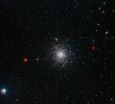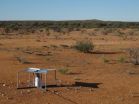(Press-News.org) The globular cluster Messier 107, also known as NGC 6171, is a compact and ancient family of stars that lies about 21 000 light-years away. Messier 107 is a bustling metropolis: thousands of stars in globular clusters like this one are concentrated into a space that is only about twenty times the distance between our Sun and its nearest stellar neighbour, Alpha Centauri, across. A significant number of these stars have already evolved into red giants, one of the last stages of a star's life, and have a yellowish colour in this image.
Globular clusters are among the oldest objects in the Universe. And since the stars within a globular cluster formed from the same cloud of interstellar matter at roughly the same time — typically over 10 billion years ago — they are all low-mass stars, as lightweights burn their hydrogen fuel supply much more slowly than stellar behemoths. Globular clusters formed during the earliest stages in the formation of their host galaxies and therefore studying these objects can give significant insights into how galaxies, and their component stars, evolve.
Messier 107 has undergone intensive observations, being one of the 160 stellar fields that was selected for the Pre-FLAMES Survey — a preliminary survey conducted between 1999 and 2002 using the 2.2-metre telescope at ESO's La Silla Observatory in Chile, to find suitable stars for follow-up observations with the VLT's spectroscopic instrument FLAMES [1]. Using FLAMES, it is possible to observe up to 130 targets at the same time, making it particularly well suited to the spectroscopic study of densely populated stellar fields, such as globular clusters.
M107 is not visible to the naked eye, but, with an apparent magnitude of about eight, it can easily be observed from a dark site with binoculars or a small telescope. The globular cluster is about 13 arcminutes across, which corresponds to about 80 light-years at its distance, and it is found in the constellation of Ophiuchus, north of the pincers of Scorpius. Roughly half of the Milky Way's known globular clusters are actually found in the constellations of Sagittarius, Scorpius and Ophiuchus, in the general direction of the centre of the Milky Way. This is because they are all in elongated orbits around the central region and are on average most likely to be seen in this direction.
Messier 107 was discovered by Pierre Méchain in April 1782 and it was added to the list of seven Additional Messier Objects that were originally not included in the final version of Messier's catalogue, which was published the previous year. On 12 May 1793, it was independently rediscovered by William Herschel, who was able to resolve this globular cluster into stars for the first time. But it was not until 1947 that this globular cluster finally took its place in Messier's catalogue as M107, making it the most recent star cluster to be added to this famous list.
This image is composed from exposures taken through the blue, green and near-infrared filters by the Wide Field Camera (WFI) on the MPG/ESO 2.2-metre telescope at the La Silla Observatory in Chile.
INFORMATION:
Notes
[1] Fibre Large Array Multi-Element Spectrograph: http://www.eso.org/sci/facilities/paranal/instruments/flames/
More information
ESO, the European Southern Observatory, is the foremost intergovernmental astronomy organisation in Europe and the world's most productive astronomical observatory. It is supported by 14 countries: Austria, Belgium, the Czech Republic, Denmark, France, Finland, Germany, Italy, the Netherlands, Portugal, Spain, Sweden, Switzerland and the United Kingdom. ESO carries out an ambitious programme focused on the design, construction and operation of powerful ground-based observing facilities enabling astronomers to make important scientific discoveries. ESO also plays a leading role in promoting and organising cooperation in astronomical research. ESO operates three unique world-class observing sites in Chile: La Silla, Paranal and Chajnantor. At Paranal, ESO operates the Very Large Telescope, the world's most advanced visible-light astronomical observatory and VISTA, the world's largest survey telescope. ESO is the European partner of a revolutionary astronomical telescope ALMA, the largest astronomical project in existence. ESO is currently planning a 42-metre European Extremely Large optical/near-infrared Telescope, the E-ELT, which will become "the world's biggest eye on the sky".
Links
- Photo of MPG/ESO 2.2-metre telescope: http://www.eso.org/public/images/esopia00046teles/
Contacts
Richard Hook
ESO, La Silla, Paranal, E-ELT and Survey Telescopes Public Information Officer
Garching, Germany
Tel: +49 89 3200 6655
Cell: +49 151 1537 3591
Email: rhook@eso.org
A swarm of ancient stars
2010-12-09
ELSE PRESS RELEASES FROM THIS DATE:
Low and high vitamin D levels in older women associated with increased likelihood of frailty
2010-12-09
Chevy Chase, MD—A recent study accepted for publication in The Endocrine Society's Journal of Clinical Endocrinology & Metabolism (JCEM) found that lower and higher vitamin D levels were associated with an increased likelihood of frailty in older women. Women with vitamin D levels between 20.0 and 29.9 ng/ml were at the lowest risk of frailty.
Vitamin D deficiency and frailty are common with aging. Dimensions of frailty, including weakness and slowness are potential outcomes of vitamin D deficiency and many experts have recommended measuring vitamin D levels in older ...
New test shows promise for accurate early diagnosis of Turner syndrome
2010-12-09
Chevy Chase, MD—A recent study accepted for publication in The Endocrine Society's Journal of Clinical Endocrinology & Metabolism (JCEM) has demonstrated a novel and accurate test for early diagnosis of Turner syndrome. Turner syndrome affects one in 1,500 to 2,000 female live births and early diagnosis allows for the timely management of short stature and co-morbid conditions including cardiac and renal problems.
Turner syndrome (TS) is the most common genetic problem affecting girls with short stature. Average adult height in untreated girls with TS is 4 feet, 8 inches, ...
Weightlifting does not appear to increase risk of arm swelling for breast cancer survivors
2010-12-09
A slowly progressive weight lifting program for breast cancer survivors did not increase their risk of lymphedema (arm swelling and discomfort), according to a study that will appear in the December 22/29 issue of JAMA. The study is being released early online to coincide with its presentation at the San Antonio Breast Cancer Symposium.
Lymphedema is a frequent complication among breast cancer survivors and ranks high among their concerns, as it may impair arm function and quality of life. "Breast cancer survivors at risk for lymphedema alter activity, limit, activity, ...
Weightlifting slashes lymphedema risk after breast cancer treatment
2010-12-09
(SAN ANTONIO) -- Weightlifting may play a key role in the prevention of the painful limb-swelling condition lymphedema following breast cancer treatment, according to new research from the University of Pennsylvania School of Medicine. Combined with the team's previous findings that the exercise limits a worsening of symptoms among women who already have lymphedema, the new data cements the reversal of long-running advice that breast cancer survivors should avoid lifting anything heavier than five pounds after they finish treatment. The research results will be presented ...
Astronomers detect first carbon-rich exoplanet
2010-12-09
CAMBRIDGE, Mass. -- A team led by a former postdoctoral researcher in MIT's Department of Earth, Atmospheric and Planetary Sciences and the MIT Kavli Institute for Astrophysics, recently measured the first-ever planetary atmosphere that is substantially enriched in carbon. The researchers found that the carbon-to-oxygen ratio of WASP-12b, an exoplanet about 1.4 times the mass of Jupiter and located about 1,200 light years away, is greater than one. As they report in a paper to be published on Dec. 8 in Nature, this carbon-rich atmosphere supports the possibility that rocky ...
ASU astronomer opens new window into early universe
2010-12-09
Thirteen billion years ago our universe was dark. There were neither stars nor galaxies; there was only hydrogen gas left over after the Big Bang. Eventually that mysterious time came to an end as the first stars ignited and their radiation transformed the nearby gas atoms into ions. This phase of the universe's history is called the Epoch of Reionization (EoR), and it is intimately linked to many fundamental questions in cosmology. But looking back so far in time presents numerous observational challenges. Arizona State University's Judd Bowman and Alan Rogers of Massachusetts ...
Euthymics presents phase II data for EB-1010 in major depression at ACNP annual meeting
2010-12-09
Euthymics Bioscience, Inc. today will present Phase II clinical data demonstrating that its lead product candidate EB-1010, a next-generation antidepressant, is effective for treating major depressive disorder (MDD) based on multiple standard measures of outcome for depression. EB-1010 also improved measures of anhedonia, a hallmark symptom of MDD, which is characterized by the inability to experience pleasure. The data further demonstrate that EB-1010 is well tolerated, without the weight gain or sexual dysfunction associated with the most common pharmacological treatments ...
Scientists map what factors influence the news agenda
2010-12-09
Computer scientists have analysed over a million news articles in 22 languages to pinpoint what factors, such as the Eurovision song contest, influence and shape the news agenda in 27 EU countries. This is the first large-scale content-analysis of cross-linguistic text using artificial intelligence techniques.
Every day hundreds of news outlets across Europe choose which story to cover from a wide and diverse selection. While each outlet may be making these choices based on individual criteria, clear patterns emerge when all these choices are studied over a large set ...
The double-edged sword of dominance
2010-12-09
A study of chimpanzees has revealed that dominant animals with higher testosterone levels tend to suffer from an increased burden of parasites. Researchers writing in BioMed Central's open access journal BioPsychoSocial Medicine observed the primates' behavior and studied their droppings to draw the link between dominance and infection status.
Michael Muehlenbein from Indiana University and David Watts from Yale University, USA, carried out the study in 22 male animals at Kibale National Park, Uganda. According to Muehlenbein, "Acquisition and maintenance of high dominance ...
Scientists forecast new atom smashers to keep Europe leading in nuclear physics
2010-12-09
Brussels, 9 December 2010 - Europe needs new particle accelerators and major upgrades to existing facilities over the next ten years to stay at the forefront of nuclear physics, according to the European Science Foundation (ESF), which launches its 'Long Range Plan 2010' for nuclear physics today.
Nuclear physicists are working to understand the origin, evolution and nature of matter that constitutes nearly 100 per cent of visible matter in the universe. As the home of GANIL, GSI, CERN and a wide network of closely collaborating facilities, Europe is world-leader in ...


